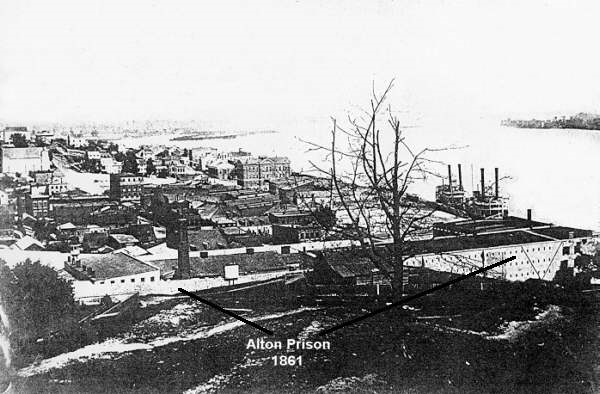An Overview of the Civil War Prison in Alton,
Illinois
by Frank Weltner,
Editor, American USSR dot
com
United States Civil War Prisons were generally dismal places with little food, medicine, or housing. Prisoners were often treated with great cruelty and provisions for food regularly degenerated to near starvation levels. Disease ran rampant through the camps where cleanliness was not considered important. Smallpox broke out in Alton Prison's 1,750 inmates causing 300 infected prisoners to be housed on a private island death camp just off short from Alton in the middle of the Mississippi River.
Article...
The Alton prison was closed, then reopened in 1862 as a major civil war prison. Alton became tainted with questions concerning hygiene when smallpox ran wild through the prison population which was then moved to an island in the Mississippi River.
The Alton prison opened in 1833 as the first Illinois State Penitentiary and was closed in 1860, when the last prisoners were moved to a new facility at Joliet. By late in 1861 an urgent need arose to relieve the overcrowding at 2 St. Louis prisons. On December 31, 1861, Major General Henry Halleck, Commander of the Department of the Missouri, ordered Lieutenant-Colonel James B. McPherson to Alton for an inspection of the closed penitentiary. Colonel McPherson reported that the prison could be made into a military prison and house up to 1,750 prisoners with improvements estimated to cost $2,415.
The first prisoners arrived at the Alton Federal Military Prison on February 9, 1862 and members of the 13 th U.S. Infantry were assigned as guards, with Colonel Sidney Burbank commanding.
During the next three years over 11,764 Confederate prisoners would pass through the gates of the Alton Prison. Of the four different classes of prisoners housed at Alton, Confederate soldiers made up most of the population. Citizens, including several women, were imprisoned here for treasonable actions, making anti-Union statements, aiding an escaped Confederate, etc. Others, classified as bushwhackers or guerillas, were imprisoned for acts against the government such as bridge burning and railroad vandalism.
THE ALTON
DEATH CAMP

HUGE DEATH COUNT
Conditions in the prison were harsh and the mortality rate was above average for a Union prison. Hot, humid summers and cold Midwestern winters took a heavy toll on prisoners already weakened by poor nourishment and inadequate clothing. The prison was overcrowded much of the time and sanitary facilities were inadequate. Pneumonia and dysentery were common killers but contagious diseases such as smallpox and rubella were the most feared. When smallpox infection became alarmingly high in the winter of 1862 and spring of 1863, a quarantine hospital was located on an island across the Mississippi River from the prison. Up to 300 prisoners and soldiers died and are buried on the island, now under water. A cemetery in North Alton that belonged to the State of Illinois was used for most that died. A monument there lists 1,534 names of Confederate soldiers that are known to have died. An additional number of civilians and Union soldiers were victims of disease and illness. During the war several different units were assigned to serve as guards at Alton. The Thirteenth U.S. Infantry was followed by the Seventy-seventh Ohio Infantry, the Thirty-seventh Iowa Infantry, the Tenth Kansas Infantry and the One Hundred Forty-fourth Illinois Infantry. Formed at Alton specifically to serve as prison guards, the Illinois 144th was almost completely made up of Alton area residents.
The prison closed July 7, 1865 when the last prisoners were released or sent to St. Louis. The buildings were torn down over the next decades and the land was eventually used by the city as a park named after the Joel Chandler Harris character, "Uncle Remus," from Song of the South. Stone from the prison buildings is found in walls and other structures all over the Alton area.


